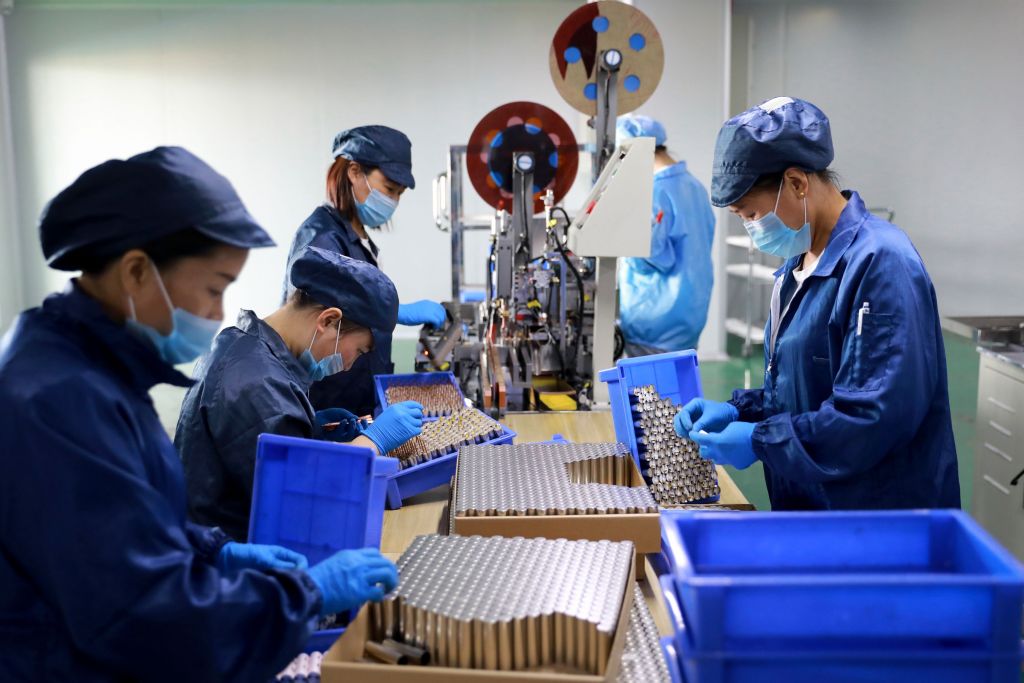A visitors holding lithium concentrate at a lithium mine in Chile. Almost three-quarters of the world’s lithium raw materials come from mines in Australia or briny lakes in Chile, giving them leverage with customers scrambling to tie-up supplies. — Bloomberg
SANTIAGO: Opaque pricing for lithium, the powerhouse metal fueling the electric vehicle revolution, is expected to be top of mind this week as the industry’s leaders gather in Santiago, with calls rising for more transparency to attract much-needed expansion funding.
Unlike for copper or other metals used to make electric cars, there is no traded price for lithium. The London Metal Exchange is working to develop a tradable price for the white metal, but until then, the industry’s investors, customers, analysts and executives are left without a full sense of the global market.
“The fact that there isn’t a benchmark price means that some of the banks haven’t been keen to get involved because they can’t hedge their price risk,” said William Adams, an analyst at Fastmarkets, which is hosting the Santiago conference and vying to be a pricing provider for the LME contract.
For now, the industry grabs on to whatever scuttlebutt it can find, with data swirling on prices for spodumene, a hard rock containing lithium; prices for hydroxide or carbonate, the two main types of lithium used in batteries; or prices paid by battery manufacturers across China, Japan and South Korea.
“You’re almost forced to just take the average of the price estimates that are out there,” said James Calaway, chairman of ioneer Ltd, which is developing a lithium project in Nevada.
While spot prices in China have dropped double digits since January due to uncertainty around the country’s electric vehicle subsidies, such prices reflect only a portion of global demand.

Employees working at a lithium battery factory in Huaibei, China's Anhui province. — AFP
Some companies, including global leader Albemarle Corp, sell nearly all of their lithium on long-term contracts and are not influenced by Chinese spot prices, a distinction many on Wall Street do not seem to make.
Albemarle’s stock is down 12 percent since January.
“The China spot price is what the market is watching and until it picks up in a meaningful way, the sentiment will be negative,” said Howard Klein, a lithium analyst and partner with New York-based advisory firm RK Equity. “But the demand is there.”
SQM, which eschews long-term contracts, said its first-quarter lithium prices slipped 11 percent, leading it to pause expansion plans in Chile’s Atacama desert.
Livent Corp, which operates in Argentina, cut its 2019 forecast and warned that demand was slipping for a version of lithium it produces in China, and would sell product elsewhere.
“Investors are valuing the industry based on the worst they’re hearing from only a handful of companies, because they don’t have a benchmark price to base analysis around,” said Ernie Ortiz, president of Lithium Royalty Corp, an affiliate of Waratah Capital Advisors, which buys lithium royalty rights.
Many long-term supply contracts are already referencing an LME price, an anticipatory step designed to set future deal parameters, Ortiz said.
“The LME is continuing to pursue the launch of a lithium contract, in close partnership with industry users,” said LME spokeswoman Bianca Blake. In addition to Fastmarkets, Argus and Benchmark Minerals are vying to supply lithium pricing data, and a decision is expected “shortly,” Blake said.
Even with the price uncertainty, though, demand is spiking. Toyota Motor Corp, for example, plans to have half of its global sales come from electric vehicles by 2025.
The lithium industry’s largest players are inking fresh expansion deals as a result. Albemarle last fall signed a $1.15 billion joint venture agreement with Mineral Resource Ltd to own and operate the Wodgina lithium mine in Western Australia, a deal that expands Albemarle’s prowess with Asian customers.
Ganfeng Lithium Co, which already has several Australian ventures, spent US$160 million to boost its stake in an Argentina lithium project with Lithium Americas Corp.
Tianqi Lithium Corp, in the world’s largest lithium deal ever, paid US$4.1 billion last year for a near-quarter stake in SQM, part of a push by Chinese companies for more lithium access.
But smaller and mid-tier players are finding it difficult to procure funding as potential financiers balk without a tradable lithium price, which would let them hedge their investment.
Neo Lithium Corp, ioneer, Standard Lithium Ltd, Sigma Lithium Resources Corp and other prospective lithium projects have all struggled to attract investors largely due to that price uncertainty.
“Greater transparency is severely needed,” said Jake Fraser, a metals analyst with Roskill.
A traded lithium price would make conversations with potential customers or financiers much easier, said Carlos Vicens, finance chief at Neo Lithium, which is developing an Argentine lithium deposit.
“Our main focus is to get a financier, a strategic partner, to get this project into construction as soon as possible,” Vicens said.










